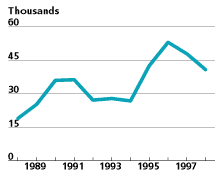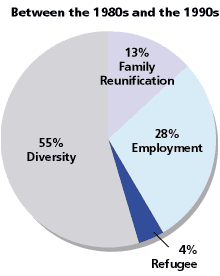
U.S. Diversity Visas Are Attracting Africa's Best and Brightest
(July 2001) Results from the 2000 Census have placed the issue of immigration front and center in U.S. public discourse. Analysts have focused primarily on the impact on this country of the large influx of Hispanics, who account for a large share of U.S. population growth. Yet new sources of immigrants have emerged in the past decade, and the impact of these new flows has not been limited to the United States.
INS data show that immigration from Africa in the 1990s climbed to 33,800 annually, more than double the level of the 1980s (see Figure 1). Though this number still represents a small fraction of U.S. immigration, it could gradually become a substantial share. And because African immigrants are disproportionately in professional, managerial, and technical (PMT) occupations — 44 percent of African immigrants to the United States who declared an occupation have PMT qualifications, compared with 34 percent of all immigrants — their departure could further undermine social and economic conditions on the African continent.
Figure 1
African Immigrants Admitted to the United States, 1988–1998

Source: U.S. Immigration and Naturalization Service, 1998 Statistical Yearbook.
The increased flow of Africans over the last 10 years has been fueled by two components of the Immigration Act of 1990: the introduction of the diversity visa program and an increase in employment visas.
The diversity visa program allotted visas known as “lottery” or “diversity” visas to natives of countries underrepresented in the immigration flow to the United States. These visas, which were meant to diversify immigration and therefore had minimal eligibility requirements, were used by African PMTs to immigrate to the United States. They provided a swift path of entry to African PMTs who could not qualify for a visa through close family ties with a U.S. resident. Between the 1980s and the 1990s, the flow of African PMTs doubled, from 2,900 annually to 5,800 annually, and diversity visas absorbed 55 percent of the growth (see Figure 2). Thus, the diversity visa program became the primary vehicle for the increased outflow of skilled Africans to the United States.
Figure 2
Growth in the Flow of African PMTs to the United States, by Category of Admission

Note: Annual average increase = 2,900.
Source: Author’s analysis of annual immigration tape files of the U.S. Immigration and Naturalization Service.
The increase in employment visas that was also part of the 1990 law spurred additional growth in the flow of African PMTs. The law dramatically increased the number of employment visas, designed to attract those with needed occupational skills to the United States. Employment visas accounted for 28 percent of the growth in African PMTs. Together, increases in diversity and employment visas that came about with changes in immigration law in 1990 accounted for over 80 percent of the growth in African PMTs.
The flow of African PMTs to the United States is still relatively small, totaling just 52,000 between 1990 and 1998, or 7 percent of the overall flow of 801,000 PMTs to the United States during that period. The flow is likely to grow, however, as African PMTs naturalize. They will then be able to use the much larger pool of family visas to bring in extended family members, many of whom — particularly spouses — are also likely to be highly skilled.
The effects of this flow on Africa may be catastrophic in light of the shortage of skills on that continent. In 1992, the Southern African Economist noted that Africa spent $4 billion per year to pay 100,000 expatriate professionals who were needed to staff aid programs on the continent. A management organization in South Africa estimated in 1996 that 400,000 extra managers were needed to supervise that country’s 10 million workers; the outflow of 2,300 South African managers to the United States in the 1990s accentuated that shortage.
The current turmoil in many parts of Africa pushes many PMTs to emigrate, in turn worsening conditions at home. But when long-term stability returns, African countries could greatly benefit from the migration of their people to the United States and other Western countries, where migrants have sharpened skills and acquired new expertise. Countries such as Korea and Taiwan, which suffered huge losses of professionals in the 1970s, are now increasingly tapping the skills of their emigrant PMTs in the United States. Both countries have organized these professionals into networks that collaborate with scientists in their countries of origin; they are also increasingly successful in bringing skilled emigrants back home. If African countries are able to draw on the skills of their PMTs in the United States, the continent may one day gain from the brain drain it is experiencing.
Arun Peter Lobo is with the Population Division of the New York City Department of City Planning. The views expressed here do not necessarily reflect the views of the City of New York. This article was excerpted from a paper that the author presented at the annual meetings of the Population Association of America, held in March in Washington, D.C.
